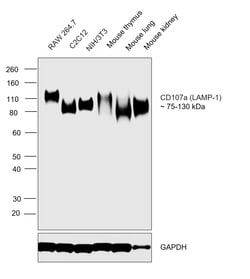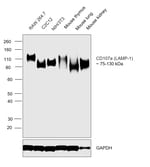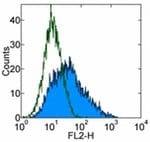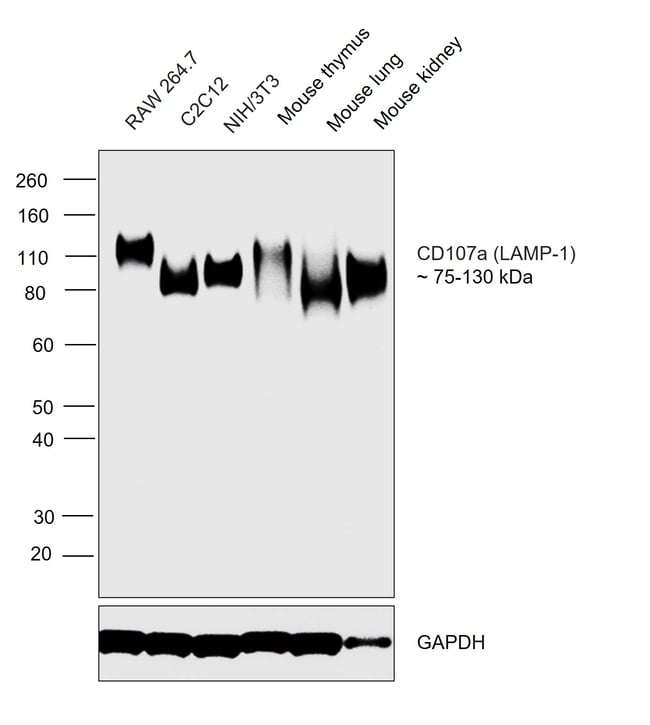Learn More
Invitrogen™ CD107a (LAMP-1) Monoclonal Antibody (eBio1D4B (1D4B)), eBioscience™, Invitrogen™
Rat Monoclonal Antibody
Brand: Invitrogen™ 14-1071-82
Description
Description: The eBio1D4B monoclonal antibody reacts with mouse CD107a, also known as lysosomal-associated membrane protein-1 (LAMP-1). CD107a is a type I, lysosomal membrane protein that is extensively glycosylated. It is expressed constitutively in the late endosomes-lysosomes in all cells. CD107a is also transiently expressed on the cell surface of degranulating cytolytic T cells. Additionally, CD107a has been implicated in a variety of cellular functions including cancer metastasis and is also a marker for lysosomal storage disorders. Applications Reported: This eBio1D4B (1D4B) antibody has been reported for use in intracellular staining followed by flow cytometric analysis, immunoprecipitation, western blotting, immunohistochemical staining of frozen tissue sections, and immunohistochemical staining of formalin-fixed paraffin embedded tissue sections. (Fluorochrome conjugated eBio1D4B (1D4B) is recommended for use in intracellular flow cytometry.). Applications Tested: This eBio1D4B (1D4B) antibody has been tested by intracellular staining and flow cytometric analysis of mouse thioglycolate-elicited peritoneal exudate cells. This can be used at less than or equal to 0.5 μg per test. A test is defined as the amount (μg) of antibody that will stain a cell sample in a final volume of 100 μL. Cell number should be determined empirically but can range from 10^5 to 10^8 cells/test.
LAMP1 (CD107a, lysosome-associated membrane protein-1) together with LAMP-2, is a major constituent of lysosomal membrane, 1-2% of total CD107a is found also on the plasma membrane. LAMP1 is a heavily glycosylated membrane protein which contains a putative signal peptide, 18 sites for N-linked glycosylation, a single membrane-spanning segment and a short (11 amino acid) cytosolic tail. The LAMP proteins are involved in lysosome biogenesis and are required for fusion of lysosomes with phagosomes. LAMP1 is a type 1 integral membrane protein that is transported from trans-Golgi network to endosomes and then lysosomes. Upon cell activation, LAMP1 transfer to the plasma membrane is dependent on a carboyxl-terminal tyrosine based motif (YXXI). Perturbation in the spacing between the tyrosine based motif relative to the membrane abolishes lysosome localization of LAMP1, and this mutant protein then cycles between the plasma membrane and the endosome. Cell surface LAMP1 (and LAMP2) have been shown to promote adhesion of human peripheral blood mononuclear cells (PBMC) to vascular endothelium, therefore, they are possibly involved in the adhesion of PBMC to the site of inflammation. Increased LAMP1 immunoreactivity is observed in neurons and glial cells surrounding senile plaques in Alzheimer's Disease (AD) cases, and is localized in medullary epithelial cells, single macrophages and lymphocytes in acute thymic involution. LAMP1 is a good marker of mast cell activation.
Specifications
| CD107a (LAMP-1) | |
| Monoclonal | |
| 0.5 mg/mL | |
| PBS with 0.09% sodium azide; pH 7.2 | |
| P11438 | |
| LAMP1 | |
| Affinity chromatography | |
| RUO | |
| 16783 | |
| 4°C | |
| Liquid |
| Flow Cytometry, Immunohistochemistry (Frozen), Immunohistochemistry (Paraffin), Immunoprecipitation, Western Blot | |
| eBio1D4B (1D4B) | |
| Unconjugated | |
| LAMP1 | |
| 120 kDa lysosomal membrane glycoprotein; AI196048; CD107 antigen-like family member A; CD107a; I79_011073; Lamp I; LAMP1; LAMP-1; LAMPA; LGP120; LGP-120; LGPA; LGP-A; lysosomal associated membrane protein 1; Lysosomal associated membrane protein 1 (120 kDa); lysosomal membrane glycoprotein 1; lysosomal membrane glycoprotein A; lysosomal-associated membrane protein 1; lysosome-associated membrane glycoprotein 1; LYSOSOME-ASSOCIATED MEMBRANE GLYCOPROTEIN 1 PRECURSOR (LAMP-1) (LGP-A) (LGP-120) (CD107A) (P2B); lysosome-associated membrane protein 1; P2B | |
| Rat | |
| 100 μg | |
| Primary | |
| Mouse | |
| Antibody | |
| IgG2a κ |
Your input is important to us. Please complete this form to provide feedback related to the content on this product.
For Research Use Only.








